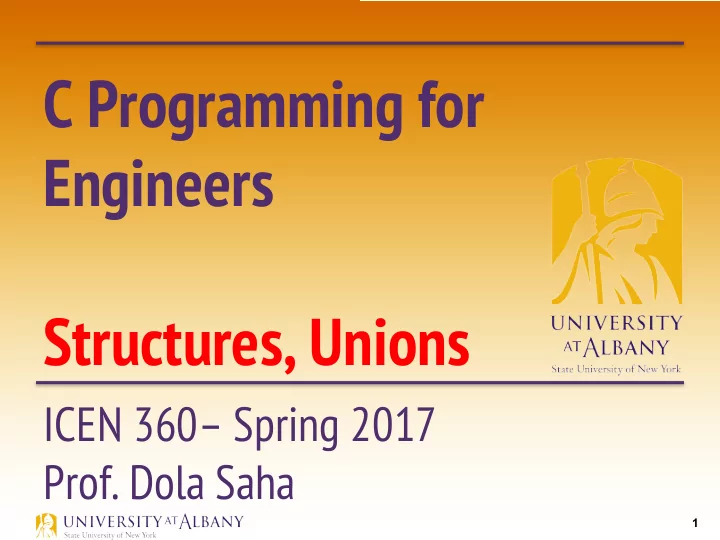

C Programming for Engineers Structures, Unions ICEN 360– Spring 2017 Prof. Dola Saha 1
Structure Ø Collections of related variables under one name. Ø Variables of may be of different data types. Tag struct card { Ø char *face; Members char *suit; }; Ø Keyword struct introduces the structure definition. Ø Members of the same structure type must have unique names, but two different structure types may contain members of the same name without conflict. 2
Structure Declaration struct employee { Ø char firstName[ 20 ]; char lastName[ 20 ]; unsigned int age; char gender; double hourlySalary; }; struct employee employee1, employee2; Ø struct employee employees[100]; Ø struct employee { Ø char firstName[ 20 ]; char lastName[ 20 ]; unsigned int age; char gender; double hourlySalary; } employee1, employee2, *employeePtr ; 3
Structure Tag Ø The structure tag name is optional. Ø If a structure definition does not contain a structure tag name, variables of the structure type may be declared only in the structure definition— not in a separate declaration. 4
Self Reference A structure cannot contain an instance of itself. Ø A variable of type struct employee cannot be declared in the Ø definition for struct employee . A pointer to struct employee , may be included. Ø For example, Ø struct employee2 { o char firstName[20]; char lastName[20]; unsigned int age; char gender; double hourlySalary; struct employee2 person; // ERROR struct employee2 *ePtr; // pointer }; struct employee2 contains an instance of itself (person), which is an Ø error. 5
Storage in Memory Ø Structures may not be compared using operators == and !=, because § structure members are not necessarily stored in consecutive bytes of memory. Ø Computers may store specific data types only on certain memory boundaries such as half-word, word or double- word boundaries. Ø A word is a standard memory unit used to store data in a computer—usually 2 bytes or 4 bytes. 6
Storage in Memory struct example { Ø char c; int i; } sample1, sample2; Possible storage, but machine dependant 7
Initialization struct card { Ø char *face; char *suit; }; Ø struct card aCard = {"Three", "Hearts"}; Ø If there are fewer initializers in the list than members in the structure, § the remaining members are automatically initialized to 0 § or NULL if the member is a pointer. Ø Assignment Statement of same struct type § struct card aCard1 = aCard2; 8
Accessing Structure Members Ø the structure member operator (.)—also called the dot operator § printf( "%s", aCard.suit); // displays Hearts Ø the structure pointer operator (->)—also called the arrow operator. § cardPtr = &aCard; § printf( "%s", cardPtr->suit); // displays Hearts § Following are equivalent o cardPtr->suit o (*cardPtr).suit 9
Example 10
Structure with Function Ø Structures may be passed to functions by § passing individual structure members § by passing an entire structure § by passing a pointer to a structure. Ø Functions can return § individual structure members § an entire structure § a pointer to a structure 11
typedef Ø The keyword typedef is a way to create synonyms (or aliases) for previously defined data types. Ø Names for structure types are often defined with typedef to create shorter type names. Ø Example: § typedef struct card Card; Card is a synonym for type struct card . Ø Example : § typedef struct { char *face; char *suit; } Card; § Card myCard, *myCardPtr, deck[52]; 12
Card Shuffling Example (1) 13
Card Shuffling Example (2) 14
Card Shuffling Example (3) 15
Card Shuffling Example (4) 16
Card Shuffling Example (5) 17
Classwork Assignment Ø Write a program to generate data for N students. Use structure to create numeric ID and points (max 100) as 2 separate members. Randomly generate data for N students. Display both the ID and the points of the student who has received highest point. 18
Union Ø A union is a derived data type —like a structure—with members that share the same storage space . Ø For different situations in a program, some variables may not be relevant, but other variables are—so a union shares the space instead of wasting storage on variables that are not being used. Ø The members of a union can be of any data type. Ø The number of bytes used to store a union must be at least enough to hold the largest member. 19
Definition union number { Ø int x; double y; }; In a declaration, a union may be initialized with a value of the same Ø type as the first union member . union number value = { 10 }; Ø union number value = { 1.43 }; // ERROR Ø 20
Permitted Operations Ø The operations that can be performed on a union are: § assigning a union to another union of the same type, § taking the address (&) of a union variable, § and accessing union members using the structure member operator and the structure pointer operator. Ø Unions may not be compared using operators == and != for the same reasons that structures cannot be compared. 21
Union Example (1) 22
Union Example (2) 23
Enumeration Keyword enum, is a set of integer enumeration constants Ø represented by identifiers. Values in an enum start with 0, unless specified otherwise, and are Ø incremented by 1. For example, the enumeration Ø enum months { o JAN, FEB, MAR, APR, MAY, JUN, JUL, AUG, SEP, OCT, NOV, DEC}; creates a new type, enum months , identifiers are set to the integers 0 to 11, respectively. Ø Example: § enum months { JAN = 1, FEB, MAR, APR, MAY, JUN, JUL, AUG, SEP, OCT, NOV, DEC}; identifiers are set to integers 1 to 12, respectively. 24
Enumeration Example 25
Enumeration Example Output 26
Recommend
More recommend